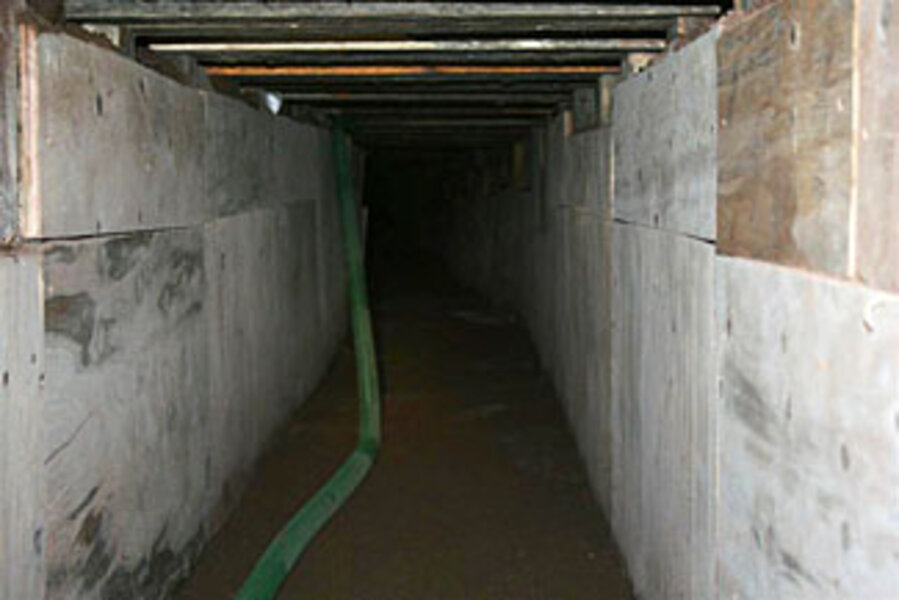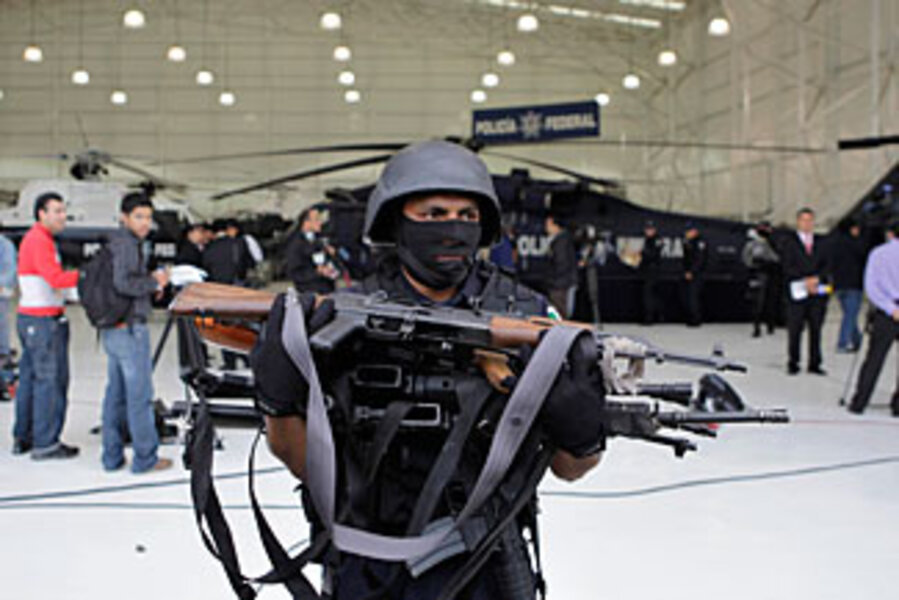Drug war's hidden front: Nogales's tunnels
Loading...
| Nogales, Ariz.
Maria Elena Leyva cannot see the problem that has recently made her hometown notorious along the US-Mexican border.
It is beneath her feet – hidden in the earth below hills speckled with mesquites, pines, and oaks.
In the words of the county sheriff, Nogales is becoming "the drug-tunnel capital of the world."
Since 1990, the US Border Patrol has found 109 tunnels along the border with Mexico, all in California and Arizona. Sixty-five – or 60 percent – have been found in Nogales, with 16 of those discovered in the past nine months.
Until the 1990s, the international line here was just a chain-link fence that allowed Americans and Mexicans to look each other in the eye, Ms. Leyva recalls, sitting on a porch only two blocks from the border. But during the past few years in particular, an arsenal of manpower, physical barriers, and electronic surveillance has made the border a virtual fortress.
This has forced drug smugglers to look for alternate means of moving marijuana, heroine, and cocaine into the US. "We've increased our enforcement on the ground, so they have to compensate for it and that's why they're developing tunnels," Border Patrol spokesman Michael Scioli says.
Many have come to Nogales, where they can tap into an underground sewer and flood-control network shared by the city of Nogales and its larger Mexican neighbor. "That's why this is probably such a unique situation," says another Border Patrol spokesman, Mark Qualia.
The tunnels are often crude – dug by hand or shovel. But they can also be sophisticated operations. One 83-foot long tunnel discovered in June was equipped with lighting and a ventilation hose. Another, discovered in 2003, had rails and a trolley system and ran 300 feet to a hillside house. A third ran to a church atop a bluff about a half mile from the border.
The sheer number of tunnels in this high desert town of 20,000 is a testament to Nogales's central role in cross-border drug smuggling.
"We do about 48 percent of the marijuana seizures in the whole country," Agent Scioli says, speaking about the Nogales area.
The Tucson sector of the Border Patrol, which encompasses Nogales in its 260 miles of border, has seized a record 1 million pounds of marijuana since the federal fiscal year began Oct. 1, 2008, he adds.
"That's the largest seizure total for any one sector in the Border Patrol since 1924," Scioli says.
Drugs flowing through Nogales generally don't stay in the area, officials say. But the activity still leaves a mark on the community.
Smugglers rent homes to tunnel through bedrooms, says Lt. Gerardo Castillo, commander of the interagency Santa Cruz County Metro Task Force.
"The houses along the border are devalued to the true homeowners," he says. "They are a very desirable location, but for the wrong reasons."
Leyva can feel the impact on her time-weathered neighborhood of rustic Sonoran-style homes and bungalows.
"They just found another tunnel not long ago – and so close to all those agents near the port of entry," she says as she waits for relatives on a muggy afternoon.
There are also safety hazards associated with tunnels. Almost two years ago, the roof of a badly constructed shaft under the port of entry collapsed.
The Border Patrol's Scioli says he has seen some that run directly under roads. "The scary part is the roof of the tunnel was your blacktop that cars and vehicles drive on every day," he says.
Although tunnels have been found along other stretches of the 2,000-mile US-Mexican border, Santa Cruz County Sheriff Tony Estrada, a lawman in the Nogales area for 40 years, says the numbers in Nogales may be unprecedented.
Agents are certainly being more watchful. "Instead of worrying about the marijuana being thrown over the fence, now we have to stay alert to tunneling systems," says Scioli.
This vigilance may be one reason tunnels are being found. "You're seeing more tunnels because maybe people are better detecting tunnels," says Anthony Coulson, head of the US Drug Enforcement Administration's Tucson office.
But as long as the high demand for drugs in the US continues, smugglers will find innovative ways to deliver, says David Shirk, director of the Trans-Border Institute at the University of San Diego.
"Regardless of whether we build walls, or whether we have another 10,000 or another 20,000 agents at the border, there's a strong economic incentive to move drugs across," he says.






